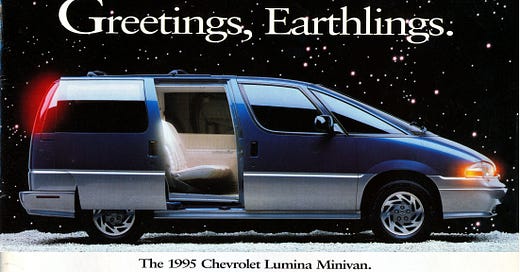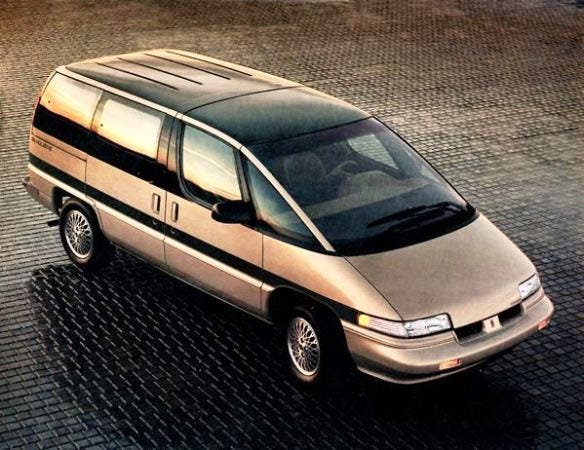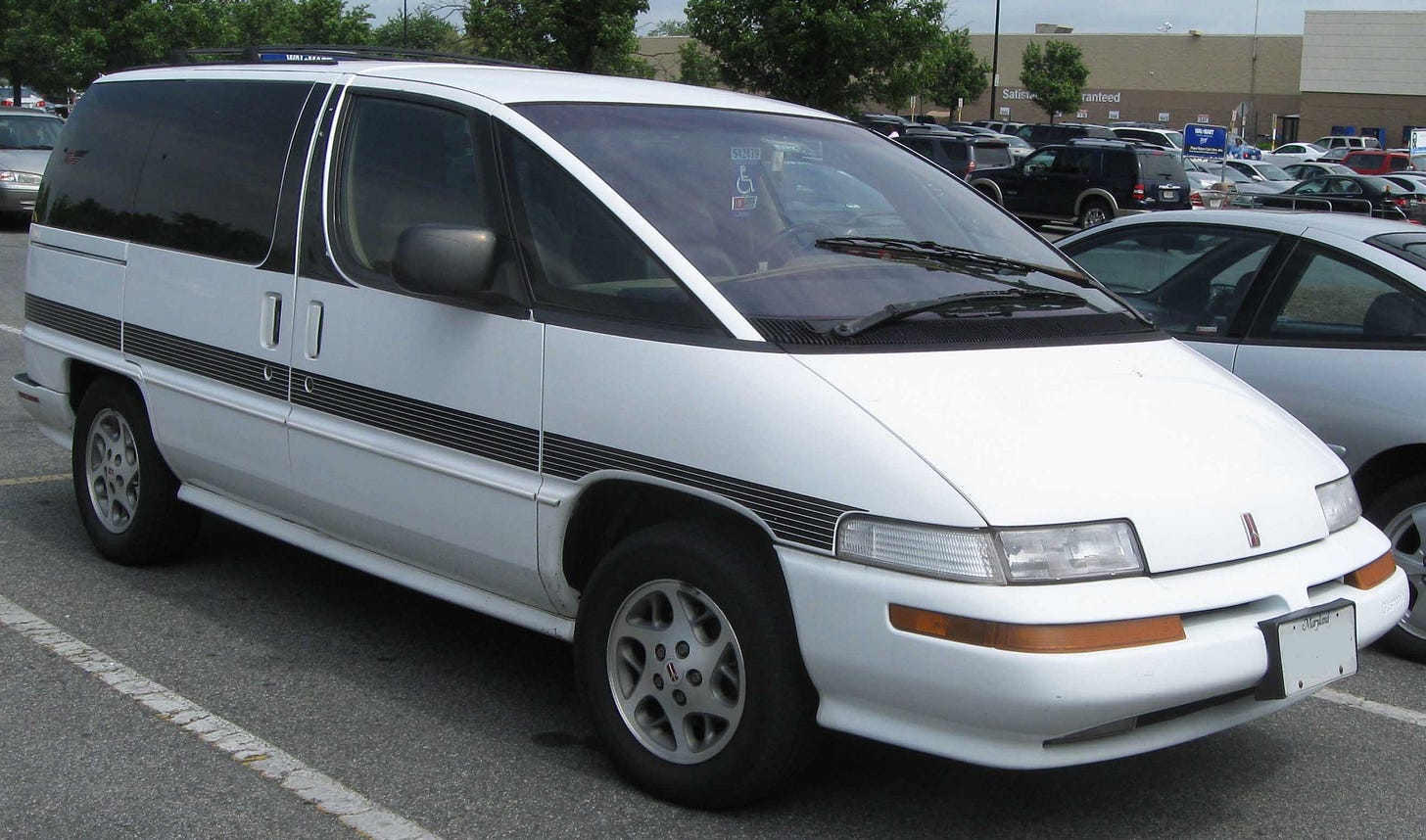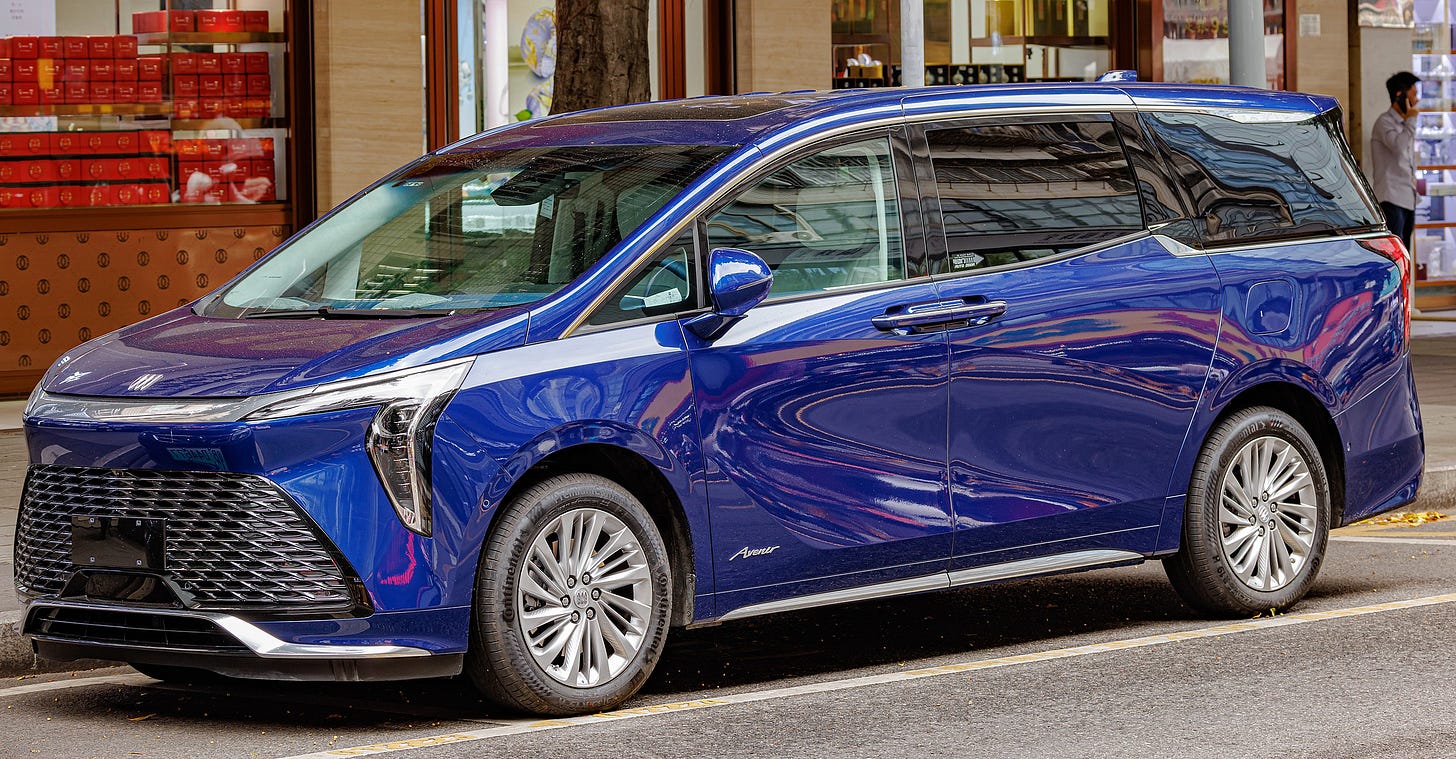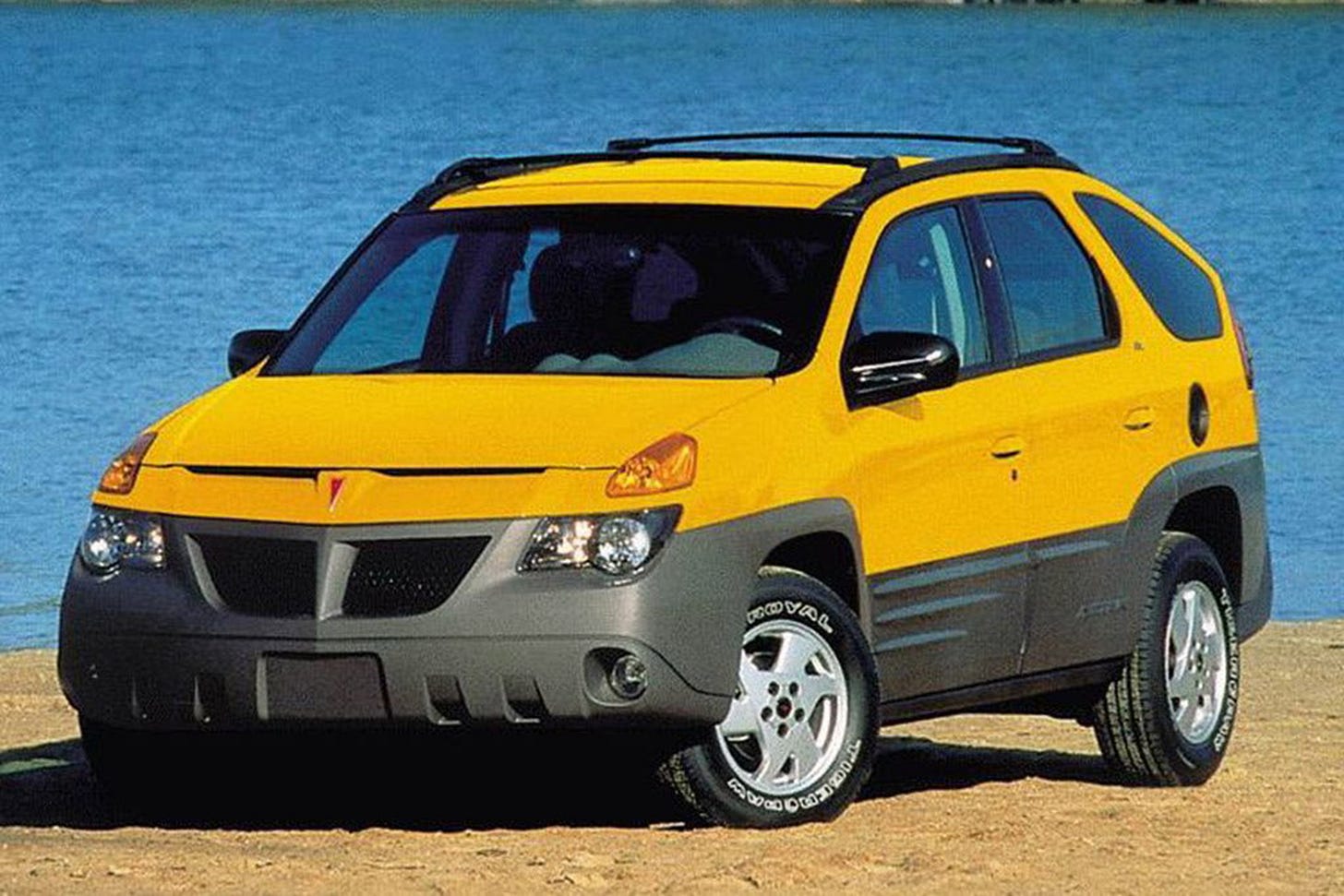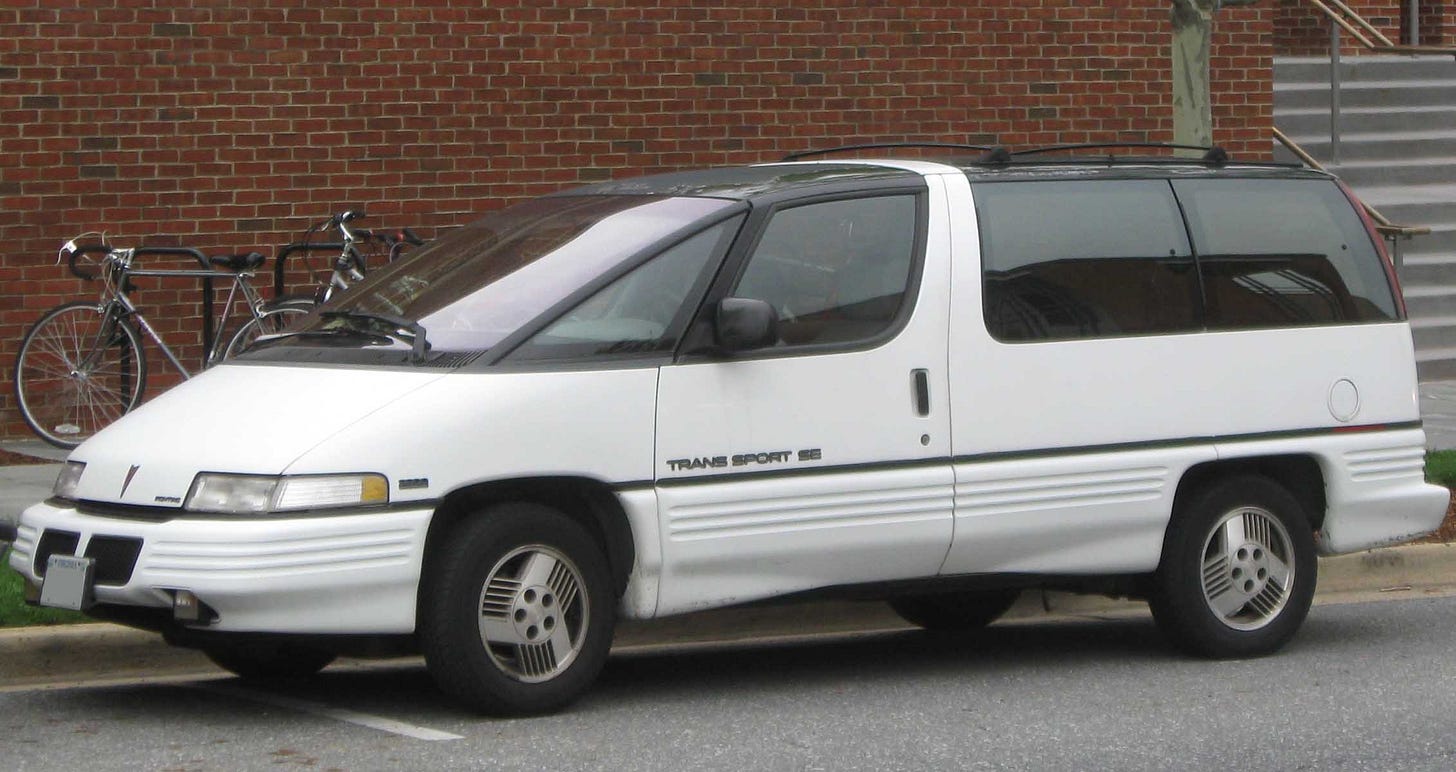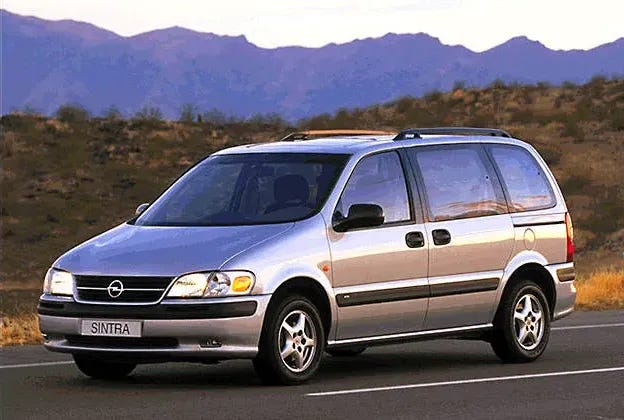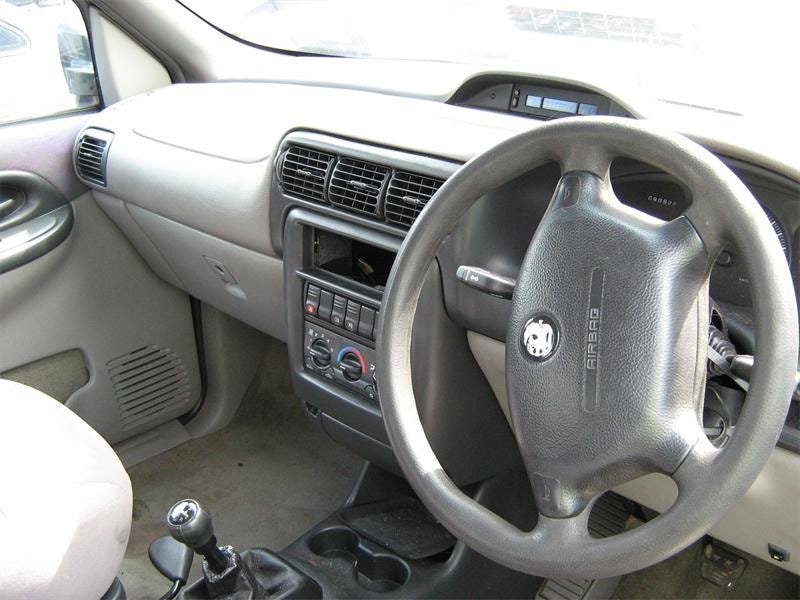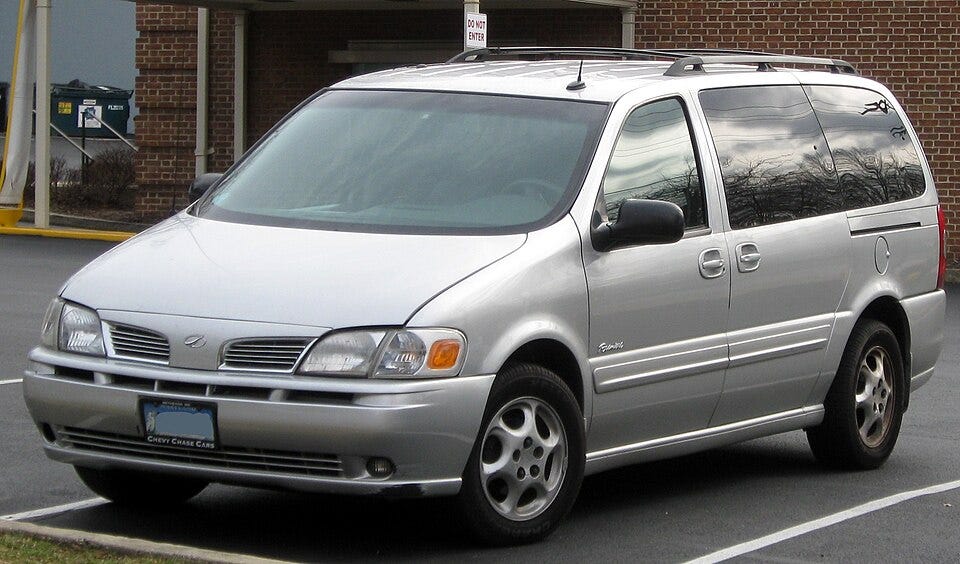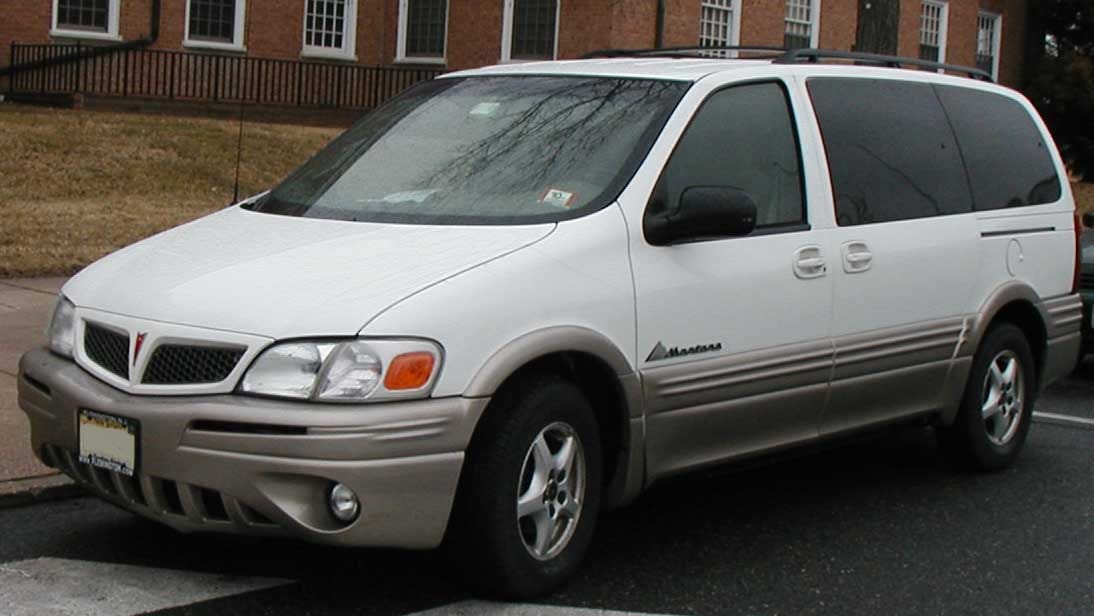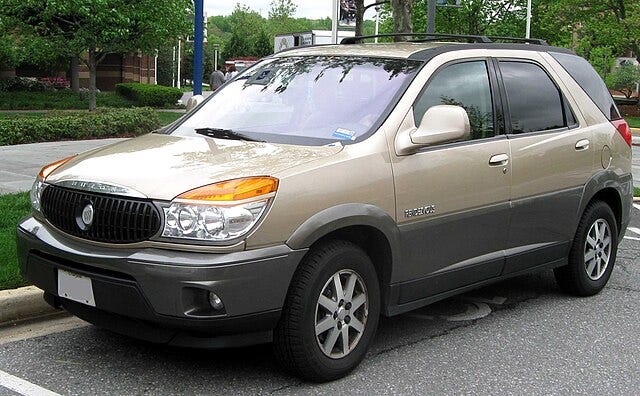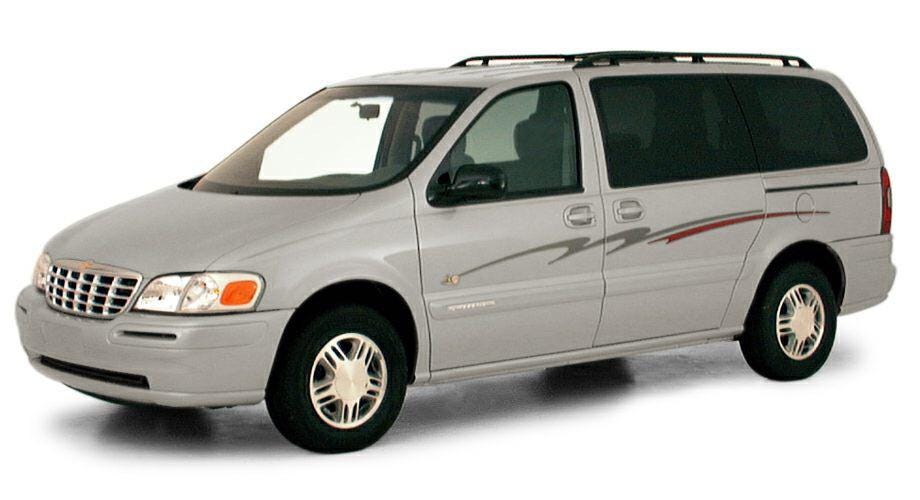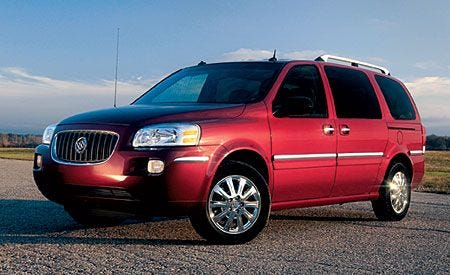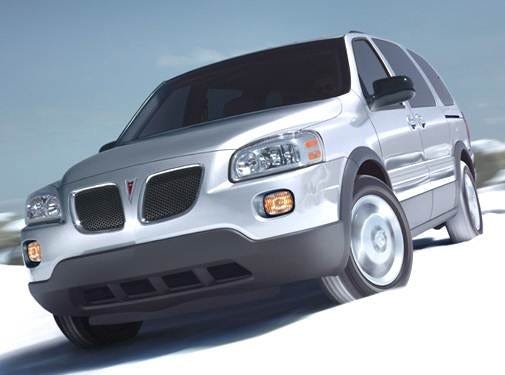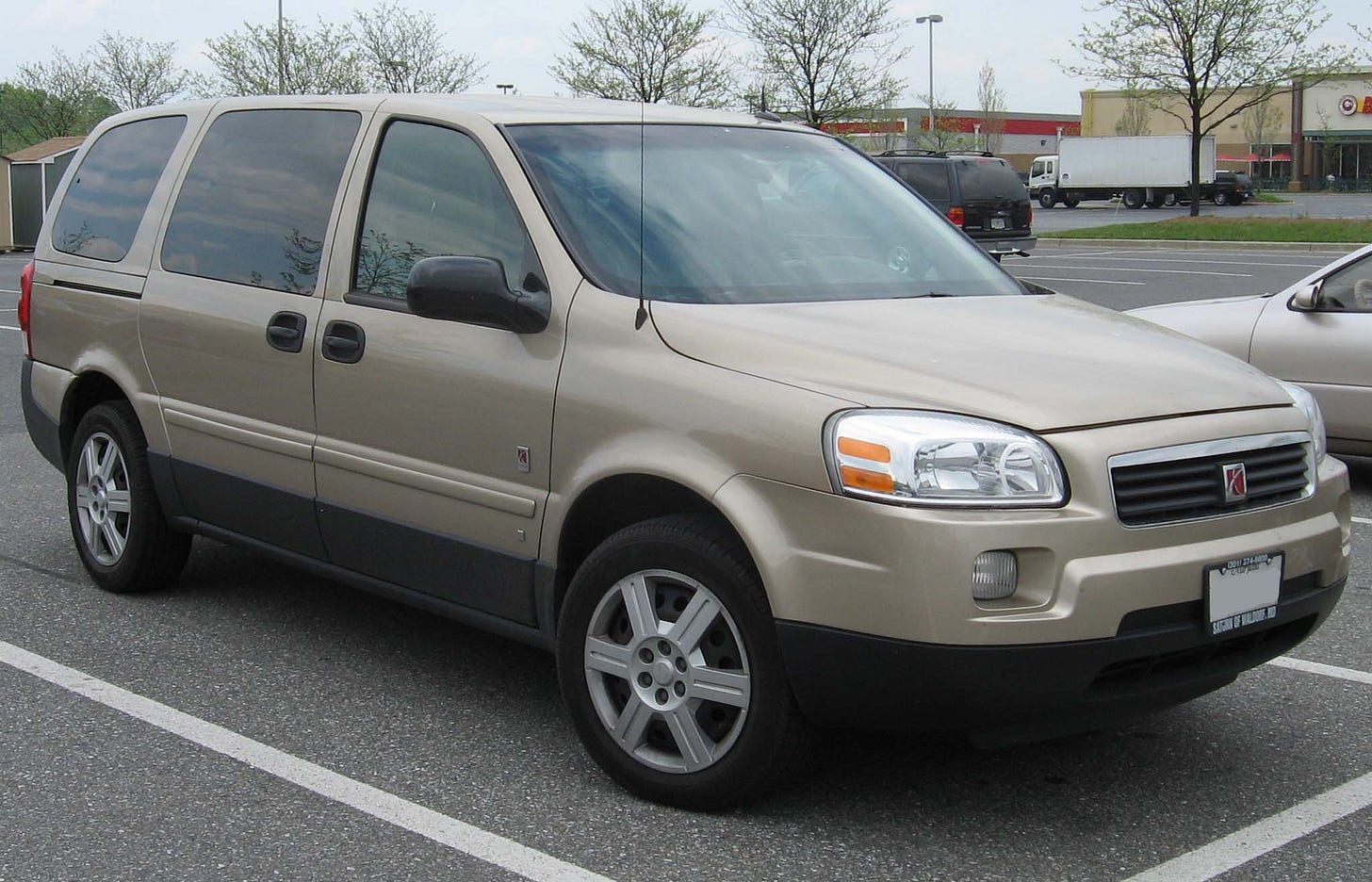The Definitive Ranking of Every GM U-Body Minivan, From “Oh Yeah!” to “Oh No…”
The weirdest, boldest, most beige plastic ever molded into family-hauling form. And somehow, it’s still alive.
I still remember my first encounter with a Dustbuster minivan: that impossibly sleek, wedge-shaped profile gliding through the pickup line at St. John's School lot like some kind of suburban spacecraft. It was the early '90s, and while other kids were hanging posters of Lamborghinis and Ferraris, I was oddly fascinated by these futuristic people-movers that looked like they'd been designed by someone who'd watched too much Star Trek.
Back in the heyday of minivans, you couldn't navigate a mall parking lot without encountering the various faces of GM's U-body platform. These weren't just transportation appliances; they were cultural touchstones, the background characters in America's family sitcom. They faithfully shuttled generations of kids to soccer practice, carried home improvement supplies with their seats removed, and featured prominently in road trips across North America.
These vans were everywhere: packed with sweaty kids outside community pools, forming constellations of brake lights in drive-throughs, loaded down with beach gear during summer breaks, waiting patiently in church parking lots with an assortment of honor roll bumper stickers proudly displayed. I grew up in their shadow as they evolved from radical space wedges to increasingly desperate attempts at SUV cosplay.
This ranking isn't based on sales figures or reliability metrics. It comes from someone who's pored over brochures at auto shows, who's spent countless hours in their second-row captain's chairs, who's slept in the back of an Aztek with its tent attachment at music festivals. Some of these takes are informed by personal experience, some from studying period reviews until my eyes glazed over, some purely from the kind of gut feeling you get when you see a vehicle that's trying so hard to be something it's not. All of them are absolutely correct.
The U-body wasn't just a one-note minivan symphony. GM threw everything at this platform, morphing it from the radical Dustbuster designs into conventional boxes, then into what they desperately branded as "Crossover Sport Vans" as the market shifted toward SUVs. There were luxury versions with leather and wood (real or otherwise), utilitarian cargo haulers, camping-ready variants with built-in tents and removable coolers, and even narrow European versions that nobody on either continent seemed to want.
And somehow, the platform survived its North American execution to live on in China, where it evolved into something genuinely upscale and desirable: a business-class lounge on wheels that executives actually choose over sedans. It's like watching the awkward kid from high school become an international success after everyone wrote them off.
So here it is: my definitive ranking of every GM U-body creation, from the genuinely innovative to the shamefully cynical, with all the plastic-fantastic stops in between. We're going from surprisingly good to "what were they thinking?" and starting with the one that somehow managed to transcend its humble origins...
#1. Oldsmobile Silhouette (1st Gen)
The self-proclaimed "Cadillac of Minivans" actually lived up to its billing. When Oldsmobile decided to build a minivan, they didn't just slap their badge on a box; they created a lounge on wheels that would have made Frank Lloyd Wright nod in approval. The first-gen Silhouette took the Dustbuster shape and civilized it with leather seating, a driver-focused cockpit, and details that actually felt premium.
Remember that scene in Get Shorty where John Travolta extols the virtues of his Silhouette? That wasn't just product placement; it was cultural acknowledgment that this van had somehow acquired an aura of cool that no minivan before or since has managed. With its composite body panels resisting parking lot dings, power everything, and an available rear air compressor for inflating sporting equipment, this was as close to a luxury spaceship as middle management could afford in 1990.
The Silhouette represented a genuine attempt to elevate the minivan beyond utility into something aspirational: a rolling statement that said, "Yes, I have children, but I still appreciate the finer things." Decades later, I still turn my head when I spot one in traffic, its distinctive profile impossible to mistake for anything else.
#2. Buick GL8 (Any Generation)
The minivan that refused to die, and instead became a genuine luxury vehicle on the other side of the world. While GM was busy killing off the U-body platform in America, Chinese executives were falling in love with the space, comfort, and presence of the GL8. It became the chariot of choice for business meetings and airport runs, eventually evolving into something truly premium.
The modern GL8 Avenir is what the Silhouette always aspired to be: a first-class cabin with power-adjustable ottomans, ambient lighting, genuine wood trim, massive touchscreens, and a level of refinement that would shock anyone who remembers the American U-bodies. It costs more than some Cadillacs, and nobody in China is embarrassed to arrive in one. In fact, it's a status symbol.
If the GL8 were sold in America, it would revolutionize how we think about luxury transportation. It's the perfect testament to the platform's unrealized potential: proof that with proper resources and commitment, the humble U-body could transcend its origins and become something genuinely desirable. Like watching your awkward cousin suddenly become an international success, the GL8's transformation is both surprising and strangely satisfying.
#3. Pontiac Aztek
Before you start yelling, hear me out. Yes, it's ugly. Yes, it became a punchline. But the Aztek was also brilliant in its own misunderstood way. Strip away the controversial styling, and what do you have? A supremely practical adventure vehicle that predicted the crossover trend years before the market caught up.
Built on the U-body platform but styled like nothing else on earth, the Aztek offered a removable center console that doubled as a cooler, an available built-in tent package that transformed it into a camper, Versatrak all-wheel drive for dirt road excursions, and an interior that could be configured in more ways than most Swiss Army knives. It was a minivan for people who would rather die than be seen in a minivan.
Breaking Bad might have given it a cultural redemption arc, but the Aztek deserved more recognition from the beginning. It represented bold thinking in an increasingly conservative automotive landscape: a vehicle designed by people who actually thought about how customers would use their cars rather than just how they would look in them. In an alternate universe where the styling was just 15% less challenging, the Aztek might have been celebrated as the versatile, innovative machine it truly was.
I rented one during a college break back in Puerto Rico, and let me tell you, that car was perfect. We went from one corner of the island to another, explored the rainforest, the beaches, the city, and the suburbs without issue. And best of all, you didn't have to look at it while you drove it.
#4. Pontiac Trans Sport (1st Gen)
The most extreme expression of the Dustbuster design philosophy, the Trans Sport looked like GM designers took a concept car sketch and sent it directly to production. With its dramatically swept windshield, shockingly low hood line, with doors the length of a composition notebook, it wasn't just a minivan; it was a statement piece.
Inside, the Trans Sport felt like a spaceship cockpit, with a wraparound dashboard that put everything within the driver's reach and visibility that made other vehicles feel like tanks by comparison. Some European models even came with Quad 4 engines and manual transmissions, proving that somewhere within GM was a product planner with a genuine sense of humor.
The Trans Sport was uncompromising in its futurism. It didn't just adopt a few modern details; it fully committed to a vision of family transportation that looked forward rather than backward. It was polarizing, impractical in some respects, and absolutely unforgettable. Driving one felt like being in a vehicle from an alternate timeline where boring design was outlawed. For sheer audacity alone, it deserves this spot in the ranking.
#5. Opel/Vauxhall Sintra
The U-body's European vacation produced the automotive equivalent of a foreign exchange student: familiar in structure but decidedly different in presentation. Built in Georgia but sold across the Atlantic, the Sintra was narrower than its American cousins and offered things that would make stateside enthusiasts drool: manual transmissions, turbo-diesel engines, and more precise switchgear. They even made a right-hand drive version and slapped a Vauxhall grill on it!
Europeans, predictably, hated it. It was too American, too plasticky, and received dismal safety ratings that doomed it to an early grave. But the Sintra represents a fascinating "what if" scenario for the U-body. What if GM had brought these powertrain options to America? What if they'd paid more attention to the driving dynamics Europeans expected? The Sintra was a flawed experiment, but its existence proved the platform had adaptability that was never fully explored in its home market.
#6. Chevrolet Lumina APV
The most pedestrian of the original Dustbuster trio, the Lumina APV brought futuristic styling to the masses but did so with less flair than its Pontiac and Oldsmobile siblings. It had the same radical profile but fewer of the premium touches that made the others memorable.
There was something democratically appealing about the Lumina APV: space-age design at relatively earthbound prices. It was the everyman's space shuttle, the choice for families who wanted something different without the premium pricing of the other GM divisions. The available Dutch doors at the rear (a split tailgate that could open as either a hatch or doors) added genuine utility that some competitors lacked.
The Lumina APV represented the median of GM's daring experiment: not as luxurious as the Silhouette or as overtly sporty as the Trans Sport, but still far more interesting than most family vehicles of its era. For bringing a touch of the future to ordinary driveways, it earns its mid-pack ranking.
#7. Oldsmobile Silhouette (2nd Gen)
When GM reined in their more radical design impulses, the second-generation Silhouette lost its spaceship aesthetic but gained a new sense of understated class. This was Oldsmobile's last real attempt at creating a premium family vehicle before the brand itself was consigned to history.
With its Premiere trim offering leather, entertainment systems, and an actual attempt at refined ride quality, the second-gen Silhouette maintained some of the original's upscale ambitions while packaging them in a more conventional box. The controversial composite body panels remained, but the overall presentation was designed to appease rather than challenge.
These later Silhouettes have aged surprisingly well, their more conservative design helping them blend into modern traffic without the double-takes the originals still generate. It was the minivan for people who appreciated quality but didn't need to shout about it, which, in retrospect, might have been a metaphor for Oldsmobile's position in GM's lineup during its final years.
#8. Pontiac Montana (1st Gen)
When suburban parents started abandoning minivans for SUVs, Pontiac's response was both cynical and kind of brilliant: make a minivan that pretends to be an SUV. The Montana added aggressive body cladding, a slightly higher ride height, and rugged marketing to a vehicle that was fundamentally still a people-mover.
The ruse worked surprisingly well. The Montana sold in respectable numbers, appealing to families who wanted SUV aesthetics but still needed sliding doors and three rows of seating. The available Versatrak all-wheel drive system added some legitimacy to its outdoorsy pretensions, and the Thunder special edition amped up the sporty visuals even further.
#9. Buick Rendezvous
The Aztek's conservative cousin took the same innovative packaging and wrapped it in a design calculated to offend absolutely no one. The result was a vehicle that blended into parking lots like beige wallpaper but retained much of what made its Pontiac sibling practically useful.
Where the Aztek shouted its presence, the Rendezvous whispered. It offered similar versatility, the same Versatrak system, and a more upscale interior, all wrapped in sheetmetal that seemed designed by a committee whose primary goal was avoiding strong opinions. This calculated inoffensiveness worked. The Rendezvous outsold the Aztek significantly.
The Rendezvous was the automotive equivalent of a politically neutral conversation at Thanksgiving dinner, designed specifically to avoid controversy at all costs. It was GM's transparent answer to their Lexus RX envy. And it proved that sometimes, bland sells better than bold.
#10. Chevrolet Venture
The vanilla ice cream of the U-body lineup: not exciting, not offensive, just reliably there. The Venture was GM's volume player, the one designed to compete directly with the Dodge Caravan and Honda Odyssey without any pretensions of luxury or sportiness. It was purely functional transportation designed for the masses.
What made the Venture interesting was its embrace of pop culture tie-ins. The Warner Brothers Edition came with built-in VHS (later DVD) entertainment systems, Looney Tunes badging, and special graphics aimed at making family road trips more bearable. It represented the minivan as an extension of the living room: a recognition that these vehicles weren't about driving pleasure but about keeping the peace in the back seats. I didn't entirely get it. But I also thought it was the coolest thing ever.
The Venture was the U-body most likely to be driven into the ground by families who viewed vehicles as appliances rather than aspirations. It wasn't great at anything, but it was decent at everything that mattered for its intended purpose. Sometimes, being thoroughly average is its own kind of achievement.
#11. Buick Terraza
Imagine a Chevy minivan that leafed through Architectural Digest and decided to drape itself in two-tone faux suede. That's the Buick Terraza: a minivan that desperately wanted to be taken seriously as a premium alternative but was still very much trapped inside a dated U-body shell.
It was Buick's first and only entry into the minivan segment in North America. A one-and-done experiment launched in 2005, the Terraza was supposed to convince premium-minded families that they didn't need an SUV to ride in style. And to its credit, it kind of worked... on paper.
This was hands-down the nicest interior of the final-gen U-bodies. Real wood trim, optional PhatNoise digital entertainment, a QuietTuning package, two-tone leather in "Cashmere" or "Graystone," and an optional Sit-N-Lift chair to help rear passengers with mobility needs. The air suspension was a nice touch, too. Buick actually went through the trouble of softening the ride in a meaningful way.
But it was also just a cherry on top of a crap sundae. Underneath all the soft-touch trim and brushed metal accents was the same tired platform shared with the Montana SV6 and Saturn Relay. It was narrow. It was underpowered. The 3.5-liter V6 was barely adequate, the 4-speed auto was already outdated, and the layout still favored fleet economics over genuine luxury. It didn't matter how nice the wood trim was. When your knees are mashed up against the second-row seatbacks and your power door takes six business days to close, the illusion wears off fast.
The Terraza tried harder than its siblings, and for that, it squeaks by with a slightly higher ranking. But no amount of cashmere-colored leather could disguise the fact that Buick was selling a dressed-up compromise. It wasn't bad; it just wasn't good enough.
#12. Pontiac Montana SV6 (2nd Gen)
GM's desperate final attempt to make minivans cool again resulted in the automotive equivalent of a midlife crisis. The Montana SV6 represented the peak of the "Crossover Sport Van" era: a cynical marketing exercise that fooled precisely no one. It wasn't a crossover. It was barely sporty. It was still very much a van.
I spent 1,100 miles in a rental SV6 once, a journey that gave me plenty of time to contemplate its existential confusion. The longer nose was supposed to evoke SUV proportions but just made it awkward to park. The higher ride height compromised handling without delivering actual off-road capability. The interior remained pure minivan, with none of the ruggedness its exterior promised. I've never been so embarrassed to drive a car.
The Montana SV6 was a vehicle designed by marketing departments rather than engineers: a transparent attempt to chase trends rather than embrace what minivans do well. It floated down the highway, shifted with all the precision of a 1970s Buick, and left absolutely no lasting impression besides mild disappointment. Sometimes, trying too hard is worse than not trying at all.
#13. Saturn Relay
Poor Saturn. The brand built on being "different" was handed a rebadged minivan that represented everything their original philosophy stood against. The Relay was badge engineering at its most cynical: a desperate attempt to give Saturn dealers something to sell as the brand circled the drain.
Unlike early Saturns with their plastic body panels and unique personalities, the Relay was just another U-body with a Saturn face grafted on. It betrayed the brand's values so completely that it might as well have worn a disguise. There was nothing "Saturn" about it beyond the badge: no polymer panels, no distinct engineering, nothing that connected it to the brand's original mission.
The Relay existed solely to fill a product planning spreadsheet cell. It wasn't terrible; it was just pointless, a vehicle without purpose or passion. For a brand that once represented a different kind of car company, the Relay was the white flag of surrender, an admission that the Saturn experiment had failed. For betraying a once-innovative brand's values so completely, it earns this position near the bottom.
#14. Chevrolet Uplander
The automotive equivalent of giving up. The Uplander represented GM's final, half-hearted attempt at relevance in a segment they once helped define. Like the Montana SV6 and Relay, it adopted the "Crossover Sport Van" nomenclature while delivering neither crossover versatility nor sporty driving dynamics.
With its extended nose, awkward proportions, and an interior that felt a generation behind the competition in both form and function, the Uplander seemed designed by people who had already accepted defeat. It wasn't just that it was bad, though it certainly wasn't good; it was that it felt so thoroughly resigned to its fate. This was a vehicle created without passion, a product that existed solely because canceling it would have been more work than simply letting it limp along until the platform was finally put out of its misery.
I remember seeing rows of them on rental lots, passed over in favor of almost anything else. The name itself felt like a placeholder that somehow made it to production: "Uplander" conveying nothing beyond a vague sense of upward motion that the vehicle itself couldn't deliver. Like someone left "Uplander" in a PowerPoint slide and no one had the heart to delete it. Or worse, someone thought it sounded aspirational. For representing the nadir of GM's minivan ambitions, it firmly deserves the bottom spot on this list.
Epilogue: The Platform That Refused to Die
The U-body's journey is one of the most fascinating in modern automotive history. From radical beginnings to desperate endings in North America, and then a phoenix-like resurrection in China, it's a platform that refused to follow a predictable script. It was stretched, reshaped, reinvented, and repurposed more times than seems possible for a single architecture.
Now, decades after the first Dustbusters rolled off assembly lines, you can still spot them occasionally: faded paint, mismatched body panels, but still rolling along with that distinctive profile. The later models blend anonymously into traffic, their mediocrity their most effective camouflage. And somewhere on the other side of the world, executives are still stepping out of GL8s at important meetings, the U-body having finally found its true calling as genuine luxury transportation.
These vans represented GM's willingness to experiment, to take chances, sometimes brilliantly, sometimes disastrously. They gave us genuine innovation alongside cynical badge engineering, radical design alongside desperate trend-chasing. They weren't always good, but they were rarely boring, and in an era where everything is converging into the same wind-tunnel-sculpted beige blob of acceptable sameness, there's something to be said for that.
For better or worse, the U-body minivans were part of America's automotive DNA for nearly two decades. They carried our families, enabled our road trips, and sometimes made us question GM's decision-making processes. They were flawed, fascinating, and occasionally fantastic, just like the company that created them.
And I kind of miss them. Not enough to buy one (except maybe an Aztek with the tent package for pure nostalgia… or a clean radwood-ready dustbuster van), but enough to appreciate what they represented: the last gasp of weird, experimental GM before bean-counters and bankruptcy reorganized the company into something more sensible but less interesting. Raise a juice box. Toast a Warner Brothers badge. Pour one out for the U-body: the platform that tried everything, failed at most of it, and somehow still lives on.
